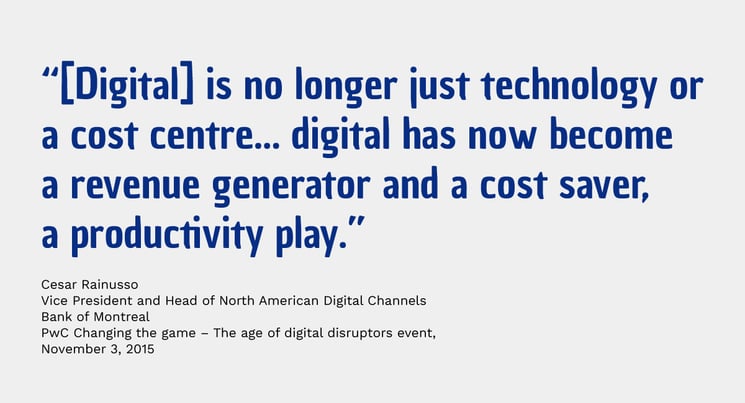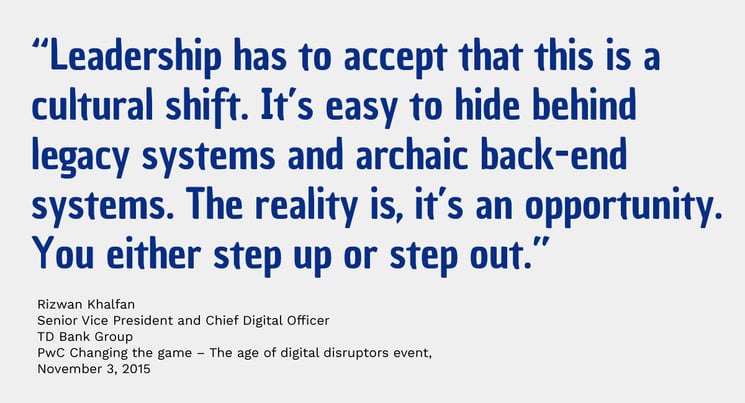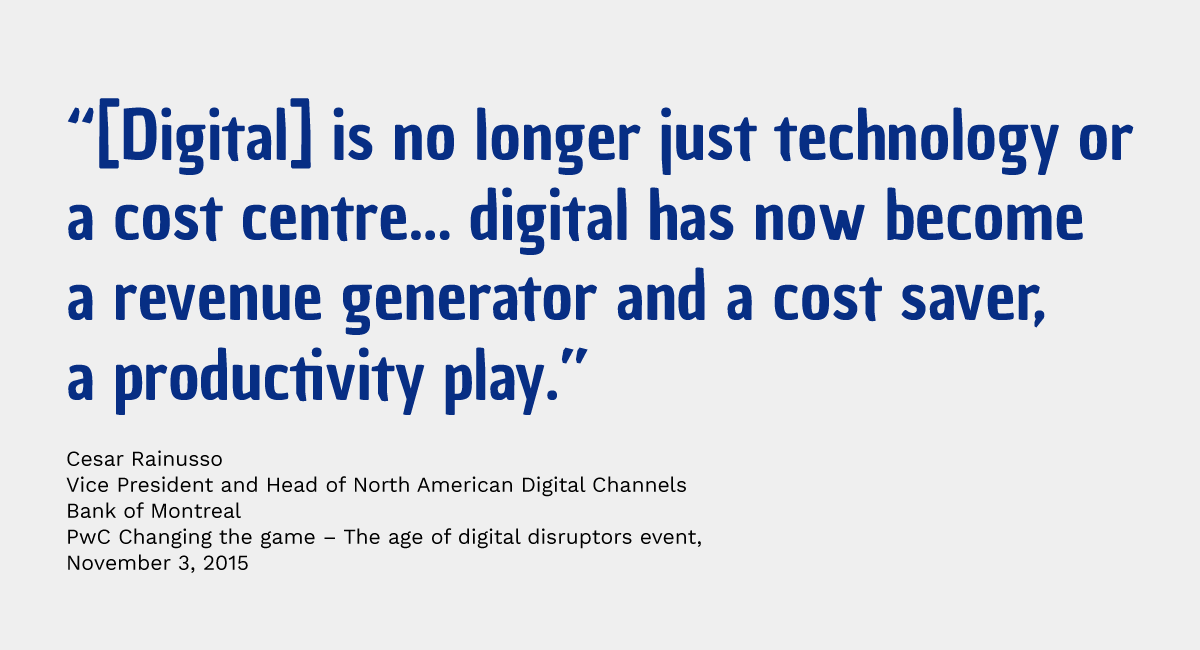In 2015, the McKinsey Global Institute stated, “banks have three to five years to become digitally proficient,” or face a dismal fate similar to the stragglers of other industries. This is a powerful and condemning statement. The end of 2018 is approaching, and while the banking industry has made significant strides in navigating digital disruption and increasing mobility, they must maintain their pace of mobile app innovation to meet customer expectations.
With the FinTech industry turning the established order of mobile banking upside down, banks are facing a unique environment bursting with both threats and opportunities. New technologies and enriched mobile app functionality are giving rise to the consumer demand for more flexibility and proactivity in their financial lives.

Source: Canadian Banks 2016: Embracing The Movement
This article will look at how customer behaviour is changing with the rise of mobile banking; mobile banking usage in Canada; barriers to adoption; challenges for banks; and strategies banks can use to benefit from new technological developments in the mobile space.
The Rise of Mobile Banking: Consumer Usage & Attitudes
Much like mobile payments, user adoption of mobile banking has been gradual rather than explosive. Since the beginnings of mobile banking, consumers have been expecting their financial providers to deliver customer experience value at the same stride as other mobile app services; and with high expectations, Canadian consumers are satisfied with their bank’s digital experience.
According to the Canadian Bankers Association (CBA), Canadian attitudes towards mobile banking and FinTech innovations are very favourable among consumers:
- In 2017, the top six Canadian banks recorded 398 million mobile banking transactions.
- 90% of Canadians say banks have done well bringing forward innovation to banking.
- 26% of Canadians say their use of mobile banking is increasing.
Canadian retail bank customers value the convenience mobile banking offers. The CBA also reports three areas of importance for consumers:
- 90% of Canadians value banking at a convenient time.
- 77% of Canadians value saving time.
- 77% of Canadians value banking from anywhere.
What’s interesting is, J.D. Power states that almost half of Canadian retail bank customers identify as “digital-centric” and 32% describe themselves as “digital-only” bankers. Mobile-only audiences are growing in Canada and more time is being spent on mobile apps, and despite the overwhelmingly positive feedback, only 17% of Canadians are mobile-only bankers.
Barriers to User Adoption
The disconnect between Canadian mobile time spend and mobile-only bankers could be a result of several factors. Though consumers are interested in greater mobile banking functionality, one of the greatest barriers to adoption is security. Many users are wary of how safe their money and personal information is when banking on their smartphones.
However, attitudes are gradually changing. Banks have exhaustive security systems in place and work around the clock to protect mobile banking customers from fraud. In fact, over the past decade, banks have invested $84.5 billion on technology, which includes technology dedicated to security measures.
Aside from security, it is possible that the low number of mobile-only bankers speaks to an ongoing commitment to multi-platform experience, or it could be that banks have yet to actualize their mobility potential to deliver customer experience value beyond what is considered standard banking.
Learn More: Artificial Intelligence in Mobile Banking: Reshaping the Customer Experience
The banking industry has done well to meet the standards FinTech innovations have created. They have pivoted at full tilt and delivered well-received digital options, but the truth is, technology isn’t slowing down to congratulate them and neither are mobile bank users. Functions, like checking account balances and recent transactions, performing transfers, depositing checks via photograph, and receiving notifications make the banking experience more valuable; however, these mobile banking features are now considered commonplace and banks need to push boundaries further. Customers today are expecting hyper-personalized customer journeys and superior convenience.
Challenges for Banks
While the rise of mobile banking and FinTech services present a wealth of opportunity, banks still face a myriad of challenges. There is an understanding that the urgency for innovation is acute, however, these impediments are still considerable barriers to change:
- Bureaucracy and organizational structures: startups enjoy a level of flexibility that large financial institutions do not
- Long development cycles: many banks are still in the process of changing processes to embrace a more agile, lean development philosophy
- Legacy systems: adopting and implementing new technologies is more difficult with long-standing systems in place
- Organizational thinking: similarly, organizational thinking needs to shift to a more proactive, agile, lean philosophy to allow banks to keep pace with changing consumer behaviours and technological advancements
- Security perception: as mentioned above, banks need to continue to work to build trust with consumers, particularly with new innovations in mobile banking and other digital services
Strategies for Banks to Improve Mobile Banking Services & Technology
Banks that don’t keep up run the risk of outside competitors capturing market share with their mobile strategies. To stay ahead of the curve, and cast the net wide in the evolving mobile banking and FinTech space, banks need to focus their efforts in several essential areas.

Source: Canadian Banks 2016: Embracing The Movement
Getting Started & Planning for the Future
In 2017, the six largest Canadian banks invested $13.3 billion in technology, but now they need to focus on aligning their processes and business goals with the long-term vision of their mobile apps. At the same time, they need to be looking at longer-term strategies that will allow them to easily embrace new technologies and capitalize on the opportunities they present.
Customer-Focused Solutions
FinTech startups are successful mainly because they take major customer friction points and eliminate them. Banks are doing this as well, but not to the same degree. As digital natives age and gain more personal wealth, their behaviour and expectations will continue to evolve. Focusing on the customer will help banks deliver the services users want and eliminate their most pressing pain points.
Specifically, banks need to focus on leveraging data and advanced analytics with a customer-focus. While it’s easy to write personalization off as a buzzword, most consumers expect targeted offerings.
Explore Different Development Philosophies
To compete with FinTech organizations, banks will need to adopt a different development philosophy. Agile, iterative processes will help banks go to market more quickly and improve offerings and services at the same pace as marketing demand. Creating a release and test culture is difficult for large banks largely due to the challenges listed above, but today’s mobile landscape calls for rapid iterations.
Collaborate and Partner Where Necessary
While banks work through some of the major barriers of advancing their technologies and rethinking their processes, partnership and collaboration will likely be necessary. There are opportunities to collaborate with FinTech companies whether that’s through mutually beneficial partnerships, acquisitions, or other forms of investment. Banks could also look to partner with experts in agile development and processes. An essential strategy will be to partner with experts in the mobile app development space to help transform organizational thinking and get products to market as internal operations transition.
Mobile banking is one of the more popular topics in banking technology right now, but it’s a window into a much larger reality which banks are facing and adapting to. Technology and evolving customer behaviours are driving change across all financial services. In this environment, remaining competitive means adapting to these changes, embracing new thinking, and leading the charge to innovate.

